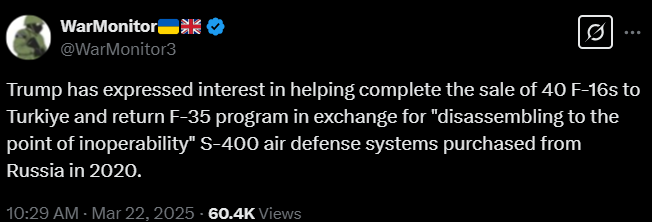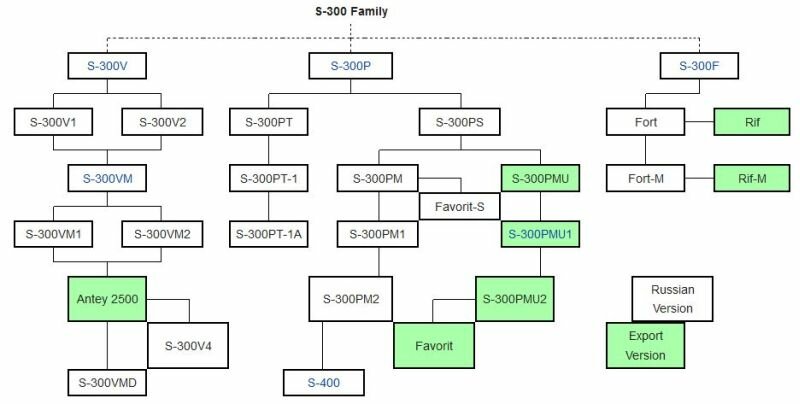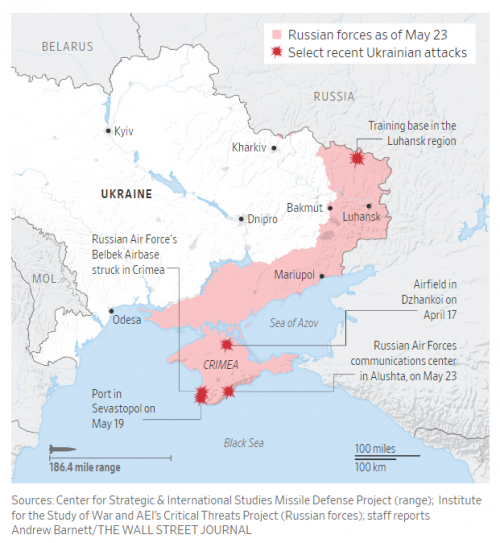It doesn't really matter where you deploy ATACMS. As a rocket artillery system, not a direct-fire weapon, it’s never positioned directly on the front line. While its apogee is lower than that of a SCUD, it still flies significantly higher than a cruise missile. At an altitude of 50–65 km, it becomes detectable by ground-based radar within a radius of approximately 939 km.
The Army Tactical Missile System (MGM-140 ATACMS) is a short-range tactical ballistic missile system developed by the United States Army. Its primary purpo

armyrecognition.com
If you looking at the map, ATACMS typically used to destroy targets pretty far behind the frontline. That the whole point of having a long range system
View attachment 764483
Beyond technical aspect, there is also the strategic and geopolitical considerations
US views India as a key partner in the Indo-Pacific strategy to counter China’s growing military power. Providing India with F-35s would enhance its air superiority and align with the security objectives of the Quad alliance (US, India, Japan, and Australia). Additionally, strengthening defense ties with India is a priority. India has been actively diversifying its military acquisitions, reducing its reliance on Russian equipment. India has successfully operated and maintained U.S. military assets like P-8 Poseidon, MH-60R helicopters, and C-17 Globemaster without security breaches.. A potential F-35 sale would further boost U.S.-India defense trade, which has expanded significantly over the past two decades.
Moreover, from a Western perspective, India shared details about the INS Chakra (Akula-class SSN) with Western partners could be seen as a strategic alignment with the West, signaling openness to deeper military cooperation. It indicate India's confidence in Western partnerships, showing that it values these relationships enough to offer insights into its military capabilities.
If you have followed U.S. politics, you would know that Democratic and Republican parties often take opposing stances on nearly every issue. This divide is even more pronounced in foreign policy.
Biden has prioritized strengthening alliances, particularly NATO, viewing Ukraine as a key partner in deterring Russian aggression. His administration sees supporting Ukraine as crucial for global security and preventing further Russian expansion.
In contrast, Trump was critical of NATO, frequently arguing that European nations should take greater responsibility for their own defense. He viewed foreign aid as wasteful and even delayed military assistance to Ukraine in 2019, which led to a political scandal and impeachment inquiry over allegations that he pressured Ukraine for political favors. Additionally, Trump sought closer ties with Russia, often questioning the necessity of direct confrontation with Putin.
Zelensky, of course, also made some mistakes.
Firstly, he invested incorrectly by siding with the Democrats, refusing to help Trump dig up dirt on Hunter Biden, and going to Pennsylvania to support Kamala... For a narcissist like Trump, that forever makes Zelensky an unforgivable enemy. And if Zelensky wanted to please Trump, he would have needed to humble himself, flatter, and express remorse... so that even if Trump couldn't truly forgive Zelensky's past 'sins,' he would at least be temporarily satisfied with such gestures. (This is also the way people like Vance or Rubio—who once harshly criticized Trump but later became his 'attack dogs' or 'puppies'—handled it.) Zelensky, though trying to be conciliatory with Trump, did not seem willing to fully yield and has never publicly praised Trump like those others. As a result, Trump has been harboring resentment, just waiting for the opportunity to explode.
Secondly, Zelensky was somewhat arrogant and did not properly assess the role or schemes of Vance. Vance has consistently opposed U.S. aid or involvement in Ukraine. But for over two months, he had been sidelined and became a marginal figure in American politics due to Musk's overwhelming influence. Desperate to regain the spotlight at any cost, he seized every opportunity from scolding European hosts on their own soil to the incident at the White House where Vance rudely interrupted the conversation between the two presidents, launching a series of provocative questions to attack Zelensky.
As I mentioned earlier, the key issue is not whether EU purchase 4th or 5th generation fighters from US, as both can theoretically be subject to US control or restrictions. The real concern for Europe is the alignment of strategic interests. The unpredictability of U.S. foreign policy especially during the Trump administration has already demonstrated the risks of over-reliance on American defense systems. Trump himself has suggested that European security concerns, such as the threat from Russia, are not necessarily America's wars to fight. This has reinforced the need for Europe to develop independent defense capabilities.
The shift away from the F-35 is driven more by political and strategic considerations than by any shortcomings in the aircraft itself. European nations want greater autonomy over their defense decisions, free from the risk of policy shifts in Washington that could restrict access to critical systems, software updates, or operational data. The push for European programs like FCAS and Tempest reflects a broader effort to ensure that future air combat capabilities are developed and controlled within Europe, reducing reliance on U.S. technology and maintaining long-term strategic independence





